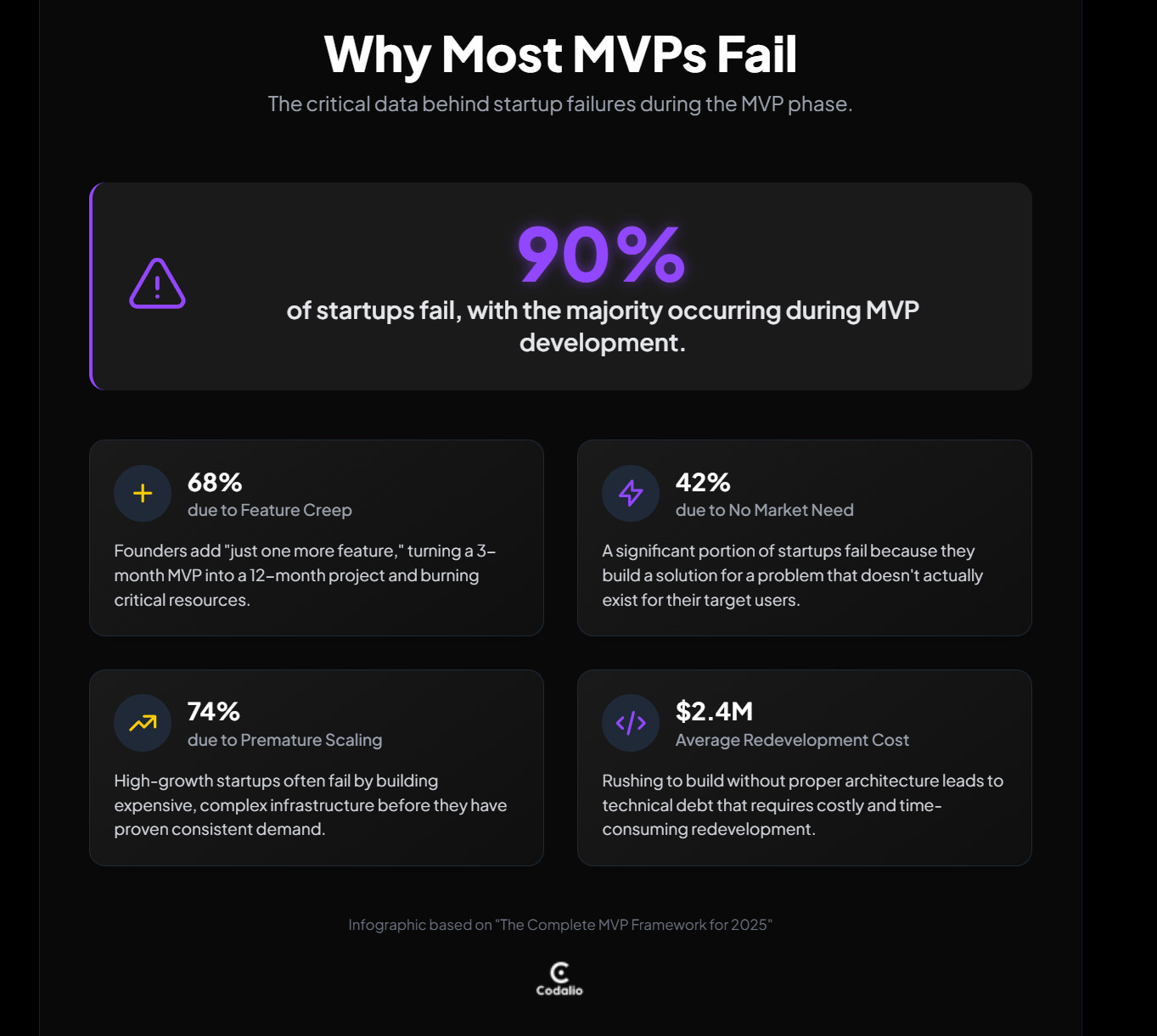Build Less, Learn More: The Founder’s Framework for Software MVP Success in 2025
Stop wasting time and money on features nobody wants.
We are going to walk you through the modern blueprint successful founders use to turn a messy idea into a market-ready product, fast.
If you’ve ever asked “Why is this taking so long?” or “Why did we go 3X over budget?”, you’re not alone. The hard truth is that up to 90% of startups fail, and it’s rarely because the idea was bad. They fail during the execution.
Key Takeaways
Execution is Everything: Most startups don’t fail because of bad ideas. They fail from a chaotic development process that wastes time and money.
A Framework Beats Guesswork: Successful founders use a systematic framework to de-risk their projects, control costs, and build with predictability.
Learn, Don’t Just Build: The goal is to create the smallest possible product to validate your idea with real users, fast. This is the “Build Less, Learn More” philosophy.
They burn through cash, add “just one more feature,” and build something nobody actually needs. They build without a blueprint. But it doesn’t have to be this way. Successful software development isn’t magic. It’s a systematic process that transforms your vision into a real product—on time and on budget.
This series is your framework.
Why Most Products Are Doomed from the Start
The number one killer of a great idea is the lack of a clear plan. Without a roadmap, you’re essentially building a house without blueprints and hoping the foundation holds.
This chaos leads to the most common startup-killers:
Feature Creep: It affects over 68% of projects, turning a lean 3-month MVP into a bloated 12-month monster.
Market Misalignment: A staggering 42% of startups fail simply because there’s no market need for what they built.
Premature Scaling: Founders build for a million users before they’ve even proven the concept with ten.
The old way of building software—disappearing for a year to build the “perfect” product in secret—is a recipe for failure. The modern, successful approach is entirely different.
The Shift: From Building Everything to Learning Fast
The goal is not to build a perfect product. The goal is to build the smallest possible thing to prove your core hypothesis. This is the “Build Less, Learn More” philosophy.
It’s about replacing risky assumptions with real-world data from actual users. This approach, which we’ll break down in this series, is your secret weapon. It allows you to control costs, manage risk, and speak the same language as your developers.
You’ll learn to validate your idea, design the right solution, build it in weeks (not months), and use data to decide what to do next.
Your Roadmap for This Series
I’m not going to just give you theory. This series is a step-by-step playbook structured around the four critical phases of the software development lifecycle.
Part 1: Foundation & Validation. We’ll start with the most important step: proving you’re solving a real problem for a specific audience before you write a single line of code.
Part 2: Design & Development. Here’s where we translate your validated problem into a product. We’ll cover feature mapping, choosing your tech, and the “6-Week Build Rule” for your MVP.
Part 3: Launch & Measurement. Getting your product into users’ hands isn’t the finish line. We’ll cover how to launch safely to a small group and track the metrics that actually matter.
Part 4: Iteration & Growth. Finally, we’ll use user feedback and data to make the most critical decision: whether to pivot or persevere. This is how you scale intelligently.
By the end, you’ll have the comprehensive framework needed to navigate the journey from idea to product-market fit with confidence.
Your TL;DR & Action Plan
The Big Idea: Successful software isn’t built on passion alone; it’s built on a disciplined framework that prioritizes learning over feature-stacking.
Why It Matters: This approach saves you time and money by ensuring you’re building something people actually want, drastically reducing your risk of failure.
Your 3-Step Playbook:
Write Your Hypothesis: Start by defining your core belief in a single sentence: “I believe [user] has [problem] which can be solved with [solution].”
Validate the Problem: Talk to at least 20 potential customers. Don’t pitch your solution; listen to their problems.
Define Your Core Feature: Based on your conversations, identify the one single feature that would solve the most painful part of their problem. That’s your starting point.
What’s the biggest assumption you’re making about your product idea right now? Share it in the comments below.
Next Blog in This Series
Read Blog2: Smart Technology Decisions for Your MVP in 2025
Stop dreaming about your app. Start building it.
Codalio helps non-technical founders turn ideas into functional scalable MVPs, just by typing them in. In minutes, not months.
👉 Sign up free today (no credit card required) https://tinyurl.com/ms2evbbd


